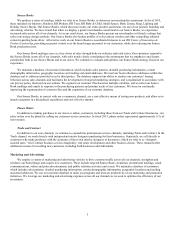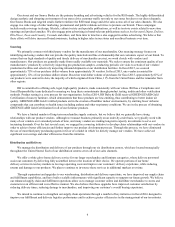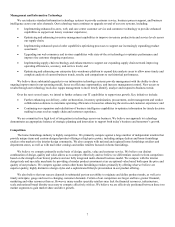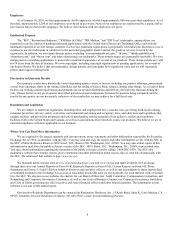Restoration Hardware 2015 Annual Report Download - page 18
Download and view the complete annual report
Please find page 18 of the 2015 Restoration Hardware annual report below. You can navigate through the pages in the report by either clicking on the pages listed below, or by using the keyword search tool below to find specific information within the annual report.15
Defective merchandise purchased from our vendors could damage our reputation and brand image and harm our business, and we
may not have adequate remedies against our vendors for defective merchandise.
We are engaged in a number of initiatives to enhance the quality of our customers’ experience, which we expect will require
significant expenditures in the near term and which are expected to include increasingly significant operational and other changes in
the near term, such as increased attention to the quality of the products that we sell. From time to time we have recalled products from
the market due to quality issues. Despite our ongoing efforts to improve customers’ satisfaction with their experience at RH, we may
fail to maintain the necessary level of quality for some of our products in order to satisfy our customers. For example, our vendors
may not be able to continuously adhere to our quality control standards, and we might not identify a quality deficiency before
merchandise ships to our stores or customers. Our failure to supply high quality merchandise in a timely and effective manner to our
customers could damage our reputation and brand image, and could lead to an increase in product returns or exchanges or customer
litigation against us and a corresponding increase in our routine and non-routine litigation costs. Further, any merchandise that does
not meet our quality standards or applicable government requirements could trigger high rates of customer complaints or returns or
could become subject to a product recall, which could in turn damage our reputation and brand image and harm our business.
Even if we detect that merchandise is defective before such merchandise is shipped to our customers, we may not be able to
return such products to the vendor, obtain a refund of our purchase price from the vendor or obtain other indemnification from the
vendor. The limited capacities of certain of our vendors may constrain the ability of such vendors to replace any defective
merchandise in a timely manner. Similarly, the limited capitalization and liquidity of certain of our vendors may result in such vendors
being unable to refund our purchase price or pay applicable penalties or damages associated with any such defects.
Our results may be adversely affected by fluctuations in raw materials, energy costs and currency exchange rates.
Increases in the prices of the components and raw materials used in our products could negatively affect the sales of our
merchandise and our product margins. Alternatively, the strength of the U.S. dollar may negatively impact the ability of some of our
customers to purchase our goods. We believe some portion of our business depends on non US consumers including sales in our stores
in Canada as well as sales in some of our U.S. based stores which have a high degree of visitors from other countries who purchase
goods from us while visiting the United States.
Changes in prices for raw materials and fluctuations in exchange rates are dependent on a number of factors beyond our control,
including macroeconomic factors which may affect commodity prices (including prices for oil, lumber and cotton); changes in supply
and demand; general economic conditions; labor costs; competition; import duties, tariffs, anti-dumping duties and other similar costs;
currency exchange rates and government regulation. In addition, energy costs have fluctuated dramatically in the past. Depending on
the nature of changes in these different factors that affect our business, we may experience an adverse impact on our business for
different reasons including increased costs of operation or lower demand for our products. We may experience slower demand from
customers in markets that depend upon energy prices for a portion of their economic activity.
Changes in the value of the U.S. dollar relative to foreign currencies, including the Chinese Yuan, may increase our vendors’
cost of business and ultimately our cost of goods sold and our selling, general and administrative costs. If we are unable to pass such
cost increases on to our customers or the higher cost of the products results in decreased demand for our products, our results of
operations would be harmed.
We are subject to risks associated with occupying substantial amounts of space, including future increases in occupancy costs. We
own certain properties, and we may choose in the future to acquire further properties, including store locations, which subject us
to additional risks.
We lease all but two of our retail store locations and we also lease our outlet stores, our corporate headquarters and our thirteen
distribution and home delivery facilities. The initial lease term of our retail stores generally ranges from ten to fifteen years, and
certain leases contain renewal options for up to twenty-five years. The initial lease term for one of our next generation Design
Galleries is forty-one years, and contains renewal options for up to fourteen years. Most leases for our retail stores provide for a
minimum rent, typically including escalating rent amounts, plus a percentage rent based upon sales after certain minimum thresholds
are achieved, as well as common area maintenance charges, real property insurance and real estate taxes. We purchased the building
and land for our store in San Francisco and one of our Toronto store locations, and we own two properties in Yountville, California,
which comprise the location of our wine tasting room and which are expected to become the location of a Design Gallery in the future.
We previously entered into a real estate joint venture transaction related to the development of our Patterson distribution center. As we
develop new stores, new store formats and other new strategic initiatives in the future, we may explore other models for our real
estate, which could include further purchases of, or joint ventures or other forms of equity ownership in, real estate interests associated
with new sites and buildings. These approaches might include complicated real estate transactions and require additional capital
investment and could present different risks related to the ownership and developments of real estate compared to those risks
associated with a traditional store lease with a landlord, including greater financial exposure if our plans for the relevant real estate are
not as successful as we originally anticipate or if the value of the real estate we acquire subsequently decreases.
























